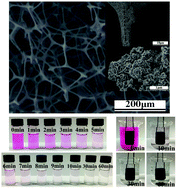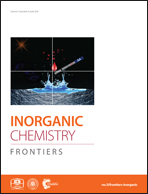A facile dip-coating method for the preparation of separable MoS2 sponges and their high-efficient adsorption behaviors of Rhodamine B†
Abstract
Molybdenum disulfide (MoS2) nanoflowers synthesized by a hydrothermal route were successfully grafted on a melamine-formaldehyde sponge through a facile dip-coating method to form MoS2 nanoflowers sponges. The MoS2 sponges exhibited high-efficient adsorption performance to cationic dye, Rhodamine B (RhB), with a maximum adsorption capacity of 104.78 mg RhB g−1 product (equal to 213.84 mg RhB g−1 MoS2 by conversion) within 60 min, which was primarily attributed to the strong electrostatic interactions between electronegative MoS2 nanoflowers and positively charged RhB molecules. The equilibrium adsorption and kinetics data fitted well with the Sips isotherm model and the pseudo-second-order kinetic model, respectively. The recyclability experiments showed that the MoS2 sponge adsorbent could be reused for 10 times with above 86.7% of the adsorption capacity retained. More remarkably, the as-prepared sponge adsorbent can be separated from the dye solution easily through a simple salvage instead of any tedious centrifugation or filtration processes. Thus, the separable MoS2 sponge adsorbent with remarkable adsorption capacity and excellent reusability for organic dyes shows promise for large scale water remediation in the future.



 Please wait while we load your content...
Please wait while we load your content...